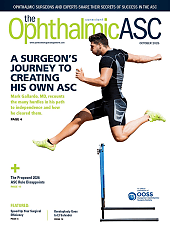Preventing Intraocular Infection and TASS
Review these 12 risk areas with your colleagues and staff.
BY PERRY S. BINDER, MD
TOXIC ANTERIOR SEGMENT SYNDROME (TASS) can cause fixed, dilated or distorted pupils; iris atrophy; loss of best-corrected distance vision; cystoid macular edema; anterior capsular phimosis; posterior capsular opacification; and secondary glaucoma with optic nerve damage.
The best treatment for TASS is prevention. I recommend that if even one case occurs, you sit down with your staff and go through all potential risk factors one at a time.

We sat down with the staff, who assured us that they were doing everything the same. When we asked how they handled the enzymatic cleaner, they explained, “We make up a fresh batch every month in a metal container and use it to digest the proteins on the instruments.”
When we went back and looked at it, we saw filaments floating in the enzymatic cleaner. We learned that when you keep the cleaner for more than a week, fungus starts eating the enzyme proteins. We were introducing fungus into our LASIK cases.
The bottom line: be sure that your staff prepares and maintains the enzymatic cleaner in the safest recommended way. We went through the list below together and I recommend that you and your staff do the same.





Toxic Anterior Segment Syndrome
Typical Findings first post-operative day (12-48 Hrs)

















It’s also important to tell your staff, “Please do not change any steps in what you do without discussing it with me first.”
Finally, stay on top of infection control in the literature and discuss it with your colleagues. Discuss any changes that you make in terms of medications, instruments and techniques so that everyone is ready to adopt them without any problems.

Perry S. Binder, MD, is a Clinical Professor at Gavin Herbert Eye Institute at the University of California, Irvine. |








